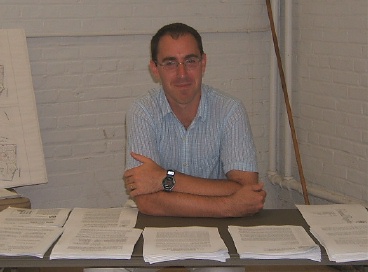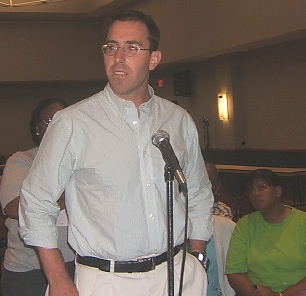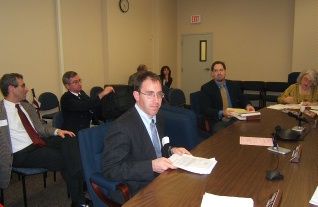 |
|
DEP Reverses Contamination Opinion on Prospect Hill
 Keith Darden is staying in the ring. File photo
Keith Darden is staying in the ring. File photo
But the Yale professor, who was the catalyst for the reversal, is not sitting down
By Sharon Bass
What if Keith Darden lived inside the Newhall consent order instead of just outside it? Would the state and the southern Hamden neighborhood still be fighting over how to clean up contaminated properties and how many millions should be spent? Or would they be fighting over whether a cleanup is even needed?
Consider.
Yesterday, letters from the state Department of Environmental Protection reached the mailboxes of Yale professor Darden and 58 other Prospect Hill homeowners -- whose property got the DEP kiss of death in November 2005 -- saying a mistake was made after all. Unlike the 300 homes within the 2003 consent order that are tagged to be remediated (some were built on top of an industrial/residential landfill), upon second opinion those in Darden’s neck of the woods are actually OK.
But getting his and other properties cleared -- something Darden's nearly fought for single-handedly -- has not led to a ceasefire with the DEP. “I’m in it for the duration. I’ve spent a huge amount of time on this and it would be nice for all that knowledge to pay off,” said Darden.
For a year, he had insisted there was nothing wrong with his or his neighbors’ yards. He conducted his own soil investigation. He shoved his own scientific analysis in front of the DEP over and over. He argued that the department’s lead contamination standards were too strict; much higher than the federal government’s. That the findings of the head contractor on the job, Loureiro Engineering Associates, were in error. Darden sniffed potential corruption and greed -- the more properties deemed needing remediation, the more money to be made. Despite being shot down over and over by the state, he refused to give up.
Now 44 of the 59 Prospect Hill properties, called a health hazard a year ago and would have cost millions and millions of dollars to remediate, have been cleared. But Darden said the fight isn’t over. There is still at least that number of homes -- also outside the consent order -- tagged for expensive remediation as well as 300 homes within the order.
The DEP conceded that Darden’s work spurred the second look. “The concerns of the Prospect Hill residents clearly made us stop and take a new look at the soil test data and the conclusions we have reached,” said department spokesman Dennis Schain.
Prospect Hill Genesis
On Nov. 28, 2005, the DEP sent letters to the 59 property owners there saying there were high lead and arsenic levels in some soil samplings, said Schain. “We clearly told them there was widespread waste fill.”
The 2005 letter said: “The department has determined that historically deposited fill materials exists [sic] on your property. The department is proposing to conduct remediation of the waste on your property at the time the area within the consent order boundary is remediated.” Some were told the contamination in their yard was more than 4 feet deep; others were told it was less.
Then Darden stepped in, and in March 2006, DEP Commissioner Gina McCarthy sent letters to the 59 Prospect Hillers saying questions had been raised about the testing and interpretation of the data. DEP staffer Diane Duva was appointed to review the findings as an “objective person not involved in the Newhall remediation project,” said Schain. “And she concluded that we had failed to make a distinction between the type of widespread historic waste fill that we found in the consent order area and the type of materials you would typically find in soil in urban and suburban areas that were long established.”
Duva looked at the same information her department did a year earlier, and produced an eight-page report that came up with a contrary conclusion. Prospect Hill soil poses no health risk.
What Changed?
“Nothing physically changed. And the data didn’t change. It was the interpretation,” said Schain. “We realized we made conclusions that really were unsubstantiated by the data.”
LEA did the testing and provided the data, and the DEP made the analysis.
So what about the 300 tagged properties in the consent order and the others right outside? Will they get another review? What if Darden lived there and fought the department’s conclusions as he did for Prospect Hill?
“This doesn’t call into question conclusions of conditions inside the consent order,” said Schain. “It’s clear from testing that there is widespread fill and in places it’s deep. It’s a totally different situation. It’s a hypothetical that doesn’t apply. The debate in the consent order is more about what the appropriate remedy is.”
That's at least in part due to the voice for the folks in the consent order, Abdul Hamid. Contrary to Darden, he's not challenging whether a cleanup is needed. Hamid is demanding a much bigger and much pricier remediation than the state proposed on Aug. 17 and which the community knocked down.

Darden speaking against Commissioner McCarthy's plan at SCSU last August. File photo
“There wouldn’t have been a consent order,” said Darden, if he lived there. “I would have fought it from the beginning.” There have been no documented or known health consequences to people living on the landfill, Darden said, and he would have argued the state lead standards.
Hush on LEA
There was no mention of LEA in Duva’s report. And that troubles Darden.
“What’s missing from this report is any blaming of the contractors, which is mind-boggling to me. It’s sort of like blaming the absence of police for a crime,” he said. The report only points to the DEP’s flaws in regards to the Prospect Hill properties.
“Everything points to a very serious problem with the contractor. The contractor did some very bad things, such as falsifying photo documentation of sampling sites and rigging the sampling,” said Darden.
Also, he contended, LEA didn’t treat the Prospect Hill area -- previously a golf course and before that the Goodrich Farm -- differently than it did the homes in the Newhall consent order that sit on the old landfill.
“Somebody threw their fireplace ashes out or used pesticides and LEA would test those spots [in Prospect Hill]. They would do samples right next to a house that had lead paint and they would write it up as this was evidence of historically deposited waste fill instead of coming from the house,” the Yale prof said. “If you used the methods they used anywhere in Connecticut you would find every area to be contaminated. LEA used a method that virtually guaranteed that the majority of properties would be contaminated.”
The contractor had also soil tested Goodrich Street to the New Haven border and part of St. Mary Street -- both areas are out of the consent order -- and deemed 50-60 properties there highly contaminated. “Many of those houses were built before the building of the Winchester [gun] plant around 1865,” said Darden. So they couldn't be on landfill because much of the lead and other contaminants found in the soil are the result of waste dumped by the gun factory.
More Money, More Money
In Duva’s report, she notes more staff, more funding and more oversight are needed at the DEP. Darden said he would agree -- if the department stopped giving work to private contractors.
“They essentially privatized their job to LEA and [LEA] did that job irresponsibly and in a way that profited themselves,” he said. “And the solution to this problem is not necessarily more oversight but punishing contractors that behaved badly and not awarding them with more work.”
Darden recalled the state auditors’ investigation earlier this year, in which they concluded the DEP awarded LEA an illegal, no-bid emergency contract for the Newhall job, which was supposed to last no longer than 60 days, but was extended to three years and several million dollars. The Attorney General’s Office is currently investigating the matter.
But the auditors also noted in the report, “DEP was justified in extending the testing into the Prospect Hill neighborhood based upon the results of testing right up to the Consent Order boundary.”
The next item on Darden’s agenda is to try to get the other 15 Prospect Hill properties cleared. “We have this ‘leave no neighbor behind’ attitude,” he said. And he said he’ll keep pushing for a very scaled-down remediation for Newhall. Certain properties must be cleaned, such as the old middle school. And there are some extremely structurally damaged homes that need attention. But he doesn’t believe that 4 feet of the topsoil from all of the 300 targeted yards need to be replaced with clean topsoil.
And as long as LEA is at the helm of the project -- the largest residential remediation in Connecticut history -- Darden vowed he’ll not sit down.
--------------------------------------------------------
Leave it for Feet

The old Waite Street Bridge. Photo/Sharon Bass
By Sharon Bass
The mood was cordially combative. The topic was the reconstruction of the Waite Street Bridge, built in 1934 and in deteriorating health. The players were residents and a few Council members in the audience before Town Engineer Al Savarese and bridge designer Fred Clark of DeCarlo & Doll in Hamden.
While there was talk at last night's public forum at Government Center about rebuilding the overpass that provides a shortcut from Waite Street to Mather, that separates Spring Glen from Whitneyville, another idea surfaced. Why spend $2 million to fix the 60-foot bridge? Take her down. Or limit use to people, not traffic.“Why do we need the bridge? Would it be better to close it down,” said Spring Glen resident John Morrison. “We have Skiff Street. We have Mather.”
The narrow bridge over Lake Whitney sees over 3,500 vehicles a day, which puts bicyclists, joggers, birdwatchers, geese and parents pushing baby strollers at risk.
“Maybe we should make it for pedestrians and get out of our cars instead of spending all this money,” said Jean Stevens of Spring Glen. The feds would foot 80 percent and the state the other 20 percent of the $2 million. The town is paying the designer $200,000, who began working on the project about a year ago. On Aug. 2, the Inland Wetlands & Watercourses Commission OK’d DeCarlo & Doll’s reconstruction plan with four conditions, one that there is cooperation with the Regional Water Authority.
“When I first heard about the bridge, I got excited,” a woman said. “But now that I know it’s going to be open to all kinds of traffic, I agree with her [pointing to Stevens]. I’d rather see it pedestrian friendly instead of vehicle friendly.”
Increased traffic and speeding seem to be the neighborhoods’ biggest worries about the reconstruction. Because of the bridge’s poor condition, a sign is currently posted limiting vehicle weight to 11 tons. When it’s rebuilt the sign will be removed and up to 40 tons would be allowed. It will be widened from 20 feet to 30 feet.
“Then you’re saying this bridge would be open to trucks coming from Stop & Shop,” a man said.
“We who live there know it’s a speedway. Can you put up speed humps?” a woman asked.
“I’m reluctant to do anything now about traffic calming without having a town-wide meeting,” Savarese said.
And Councilwoman Gretchen Callahan of Spring Glen said humps would not work because police and fire vehicles traverse the bridge. It’s also a school bus route, she said.
Morrison voiced concern that big, heavy trucks using the little bridge could fall off and taint the drinking-water supply below. “I think it’s a major consideration,” he said. “When you have trucks full of heating fuel and it hits a patch of ice, it’s gonna go right into the lake.”
As is, four to five cars a year veer off the bridge, though no one drowns or gets injured, said Savarese. That’s because the vehicles go through a fence and then some brush and either get stuck in the mud or land at the water’s edge.
When Stevens asked Clark how long the bridge would be shut down during the construction, the conversation reverted to why it’s needed.
Clark said construction would take a year and the bridge would be closed for six months of it.
“So why don’t we just learn to live without it and get over it?” she said. “Make it pedestrian friendly.”December 20, 2006
Smut on State

Video Liquidators is under new management.
A little-known Hamden porn shop, complete with zoning violations and back taxes, just changed hands
Story and photos by Sharon Bass
Mayor Craig Henrici said he didn’t know it existed. Same with Town Planner Leslie Creane. Even former Mayor John Carusone, who has lived his entire 70 years in the State Street neighborhood, was surprised to learn that a sex store has existed at 2259 State St. since 1992.
About a month ago, Dave Moon bought Video Liquidators from Crocker Properties, which owns the building and adjacent properties. Moon retained the name but jazzed up the outside to draw more attention.But customers are not the only thing Moon is attracting. The business is rife with violations. It did not pay its real or personal property taxes last July, according to the town Tax Office. And it hasn’t filed a personal property declaration since 2002 and has been fined.
Creane said Liquidators needs a special zoning permit for continuation of use, which it hasn’t applied for. It’s also questionable whether “adult entertainment” is even allowed there. Sec. 738 of the zoning regulations prohibits porn in all but M-1 (manufacturing) districts, the town planner said. Liquidators is in a CDD (controlled development district). If the business opened before 1982, Creane said it could have been grand fathered in. But it missed that cutoff by a decade.
And 6th District Councilman Curt Leng said a sign the new owner just put on the grassy strip outside his store is illegal because it’s a folding sign. Moon has also plastered signs advertising his sex wares on the darkly tinted store windows.

The folding sign.
“If it was in my power [the sex shop] wouldn’t be there,” said Leng. He said he knew about Video Liquidators but was unaware it had changed hands. “I would hope Planning & Zoning would do an inspection and fully enforce the zoning regs on them if they’re in violation, and it sounds like they are.”
Creane said she would look into it.
The store with rows and rows of triple-x videos, magazines, vibrators, dildos, “adult” lingerie and other sex toys -- plus a small head shop of glass pipes and bowls -- is just one-third of a mile from West Woods Christian Academy at 2105 State St.
Moon defended his store during a phone interview. Unlike the court fight over a proposed adult book and video shop with private viewing booths slated for North Haven, he said his does not have booths. “Those places are hell holes,” said Moon.
“It’s an adult boutique with marital aids,” he described his new shop. “It’s not a cruising spot.” When brothers Bob and Tom Crocker ran Video Liquidators, Moon said it was “dirty” and he has cleaned it up.
He refused to comment further referring questions to his attorney. However, Moon refused to disclose his lawyer’s name.
When the business was established in 1992, it was described as such on assessing records: “We sell specially [sic] video tapes. They do not cost what normal theatrical release tapes cost ($60-$100). Most expensive tapes $16-$18.” It also notes that videos are a small part of the biz, describing the bulk of the merchandise as: “ … discount used items.” Appraisal Vision records show Crocker Properties purchased the State Street parcels from James Ferriola in 2002.
No Deal
Economic Development Director Dale Kroop and Leng met with the Crocker brothers and the owner of No.1 Fish Market about six months ago. The fish market is on the southern side of the property and wants to expand its business, said Kroop. And the Crockers want to revitalize the property, which includes a rusty, old, empty Quonset hut that was once a metal finishing company. Reportedly, there was drug dealing going on inside the hut.
“We talked about all sorts of scenarios. But the same problem remains,” Kroop said. Charles White, who owns the hut and leases the land it sits on, won’t budge to allow the market to grow. He bought the hut in 1994 and signed two 99-year leases -- on the same piece of land -- with Ferriola for just $1 a year, said Kroop. The Crockers inherited the lease when they bought the property.
“So the whole thing fell apart,” Kroop said of the meeting. “We would love to see the property updated. It’s the only property left on State Street that’s dilapidated and has potential to be upgraded a lot.”December 18, 2006
'Turkish' Grocery Coming to State Street

Town Economic Development guy Dale Kroop in front of the defunct Nation's on State Street. File photo
By Sharon Bass
Since the old A&P on lower State Street closed shop in 1997, two other grocers have tried to make a go of it there. Now, make that three. Limon Fine Foods (pronounced “lemon” or “leemone”) is fixing to take over the empty store in a month or so.
Folks who live in the 6th District neighborhood have missed the convenience of a market around the corner.“I like the idea of having foods that are already prepared,” said Joanne Kittredge of Webb Street. “I got real excited about the last one [Nation’s] and I shopped there almost every day. I’m just hoping that [Limon’s] has better luck. I’d like to see the neighborhood support them.”
“It’s about bringing quality and fresh foods to the local neighborhood,” said Peter Terralavoro of Stamford. He has teamed up with the Turkish owners of Zeytinia Gourmet Markets and Amish Fine Food shops -- with locations in Connecticut, New York, Massachusetts and New Jersey -- to bring to Hamden a Turkish-style market with plenty of American food items and homemade meals to go.
“It’s got the whole Mediterranean feel to it,” said Terralavoro, who calls himself Turkish through marriage. He currently works at a Zeytinia Market in Croton-on-the-Hudson, N.Y. He said he signed a 25-year lease with Richard Cuomo, who asked to be identified as the “building manager.”
Terralavoro said Limon will have a bakery with Mediterranean baked goods, such as baklava, and café lattes and espressos, as well as the standard muffins, cookies, etc. There will be a “large salad bar” with stuff like baba ganoush, hummus, 15-20 prepared salads and soups. Plans call for prepared meals like chicken parmagian, spinach pie and falafel. Produce from New York City. General grocery items. Catering and delivery. And open seven days a week, hours to be determined.
“Imported goods from all over the world you generally wouldn’t find in a Stop & Shop,” he said. “Big Turkish candies to Turkish yogurt. Cheeses from France, Italy and Turkey.”
According to Cuomo, the A&P was there from 1962-1997, succumbing to the super supermarkets. After a three-year hiatus, Cash & Carry arrived and shut in 2004. Nation’s opened in January 2005 and closed that June.
Limon’s opening is slated for mid-January or the beginning of February.December 14, 2006
How About a Fine?

Keith Darden before the state commission Thursday afternoon. Behind him are DEP officials. Photo/Sharon Bass
Newhall rezzie asks the FOI Commission to fine the DEP for misconduct
By Sharon Bass
HARTFORD, Conn. -- Yesterday afternoon, a dreary, gray, rainy one, Keith Darden made his last voyage to the Freedom of Information Commission in Hartford. He’s been fighting the Department of Environmental Protection on how it’s conducting the Newhall remediation project. When the Morse Street man -- whose property is one of 437 in the southern Hamden neighborhood tagged by the state as contaminated -- requested documentation on soil testings and payments to a no-bid contractor, he said he got stonewalled.
So he filed a complaint with the FOI Commission. Based on a hearing officer’s opinion, the commission ruled on Nov. 7 that the DEP did not provide the requested documents to Darden in a timely fashion. And also upheld the officer’s suggestion that the DEP should not be fined. So Darden, a Yale political science professor, returned to the hot, stuffy commission hearing room -- “It’s sweltering in here,” said one of the many lawyers at yesterday’s meeting -- to implore the four-member commission to impose a fine on the DEP.
A few DEP heavyweights showed up. Staff attorney Dean Applefield, spokesman Dennis Schain and another man.
Darden has almost single-handedly challenged the department for allegedly sensationalizing the contamination problem in the Newhall area. For pricey soil testing outside the 2003 consent order boundaries, and claiming 127 homes there plus another 300 inside the order need to have their yards excavated and replaced with clean topsoil. The 127 homes, he has said many times, were built on a golf course that used to be a farm. Whereas, properties inside the consent order were developed on an industrial/residential landfill. The main contaminant is lead, and Darden also argues, having done his own investigation and soil samplings, that the DEP's threshold is way too low and therefore many of the 427 homes don’t need to be touched.
The more testing and the more properties labeled needing remediation, the more money for the DEP and its contractors. Darden has questioned the legality of the no-bid contracts, worth millions, the DEP has given Loureiro Engineering Associates to work on the remediation project. The attorney general is currently investigating the matter.
'We Did the Best We Could'
The commission clerk read the agenda. Darden was near the bottom of the list. The clerk stated everyone gets 10 minutes to speak. Darden’s case wouldn’t be heard for over two hours.
His tussle with the DEP began on March 1, 2006. He submitted an FOI request to the department for soil sample reports, financial documents and all correspondence about the project -- letters and e-mails. Darden, a member of the Newhall Advisory Committee, said he got very little.
He filed a complaint with the FOI commission, and he and the DEP filed briefs. On June 7, the case was heard. Last month, the commissioners agreed with hearing officer, attorney Barbara Housen, that the DEP was in violation of the FOI Act but didn’t impose a fine.
“What bothers me and why I’m pursuing it is that this is something [gathering the FOI’d documents] that could have been done in a few minutes,” Darden said on the dreary drive up to the capital.
“They were deliberately withholding the information from me,” he said.
The DEP not only disagreed but also had a different take on the hearing officer’s opinion that was submitted to the commission for the June meeting.
“We’re satisfied with the [June] findings of the hearing officer,” said DEP’s Schain. “We fully understand our obligations to live up to the spirit and letter of the FOI requirements. But the hearing officer found [Darden’s] request was not a typical records request.” He said when Darden first FOI’d for the records on March 1, there were other entities, such as the NAC, that also wanted to review them, placing a bigger burden on the department to comply with everyone. However, Schain said he couldn’t remember when the other requests were made. Darden maintained they came in a month after his and the NAC only wanted financial records, not the soil samples.
“The DEP was trying its best to comply and do its job. This is an ongoing remediation process,” said attorney Applefield. He said it was “very time consuming” to fill Darden’s order. “I’m not sure exactly what else the DEP could have done.”
“We did the best we could,” said Schain.
Darden got his first chance to review some of the materials in late March. But nearly three months later, the department still hadn’t supplied him with all he requested and thus the FOI complaint. Some time after the June 7 hearing, Darden got everything on his FOI list.
He said he found some enlightening stuff. There was an e-mail from LEA to Elsie Patton, former director of remediation for DEP, inviting her to a personal birthday party.
“We were trying to distinguish between strong mismanagement and corruption” in the Newhall project, said Darden. He also found that LEA did soil samplings in 2003 and again in 2005, retesting some of the homes. In 2005, the contractor expanded the testing outside the consent order, hitting properties such as Darden’s, which ignited his opposition.
“The testing they did in 2003 suggested they didn’t need to go further,” he said. “So why in 2005 did they test those homes again and go further? So LEA makes more money and creates a bigger cleanup. The first thing we (two neighbors and state Rep. Peter Villano) did was try to get the DEP to get a new contractor.” But the department didn’t. “They’re very close to LEA.”
Snap Decision
At about 4:30 p.m., Darden and the DEP sat before the commission. It took about five minutes. The commission upheld the findings by Housen, including not levying a fine.
Walking to his car at sunset, Darden said he wasn’t surprised. “It seems the commission always upholds the hearing officers’ decisions,” he said, and drove home to Hamden.
December 8, 2006
School of Dreams

The "outdoor group" throws around ideas. Frank Cooper of Parks & Rec is in the back, Town Planner Leslie Creane is on the right and Whitneyville activist Kelly McCarthy sits across.
The community meets again to discuss the destiny of the old middle school
Story and visuals by Sharon Bass
Ideas are not wanting for how to transform the old middle school on Newhall Street. But money is.
North Haven landscape artist Mark Papa draws the dreams for the rebirth of the old middle school, last night. Click the arrow to hear him talk about them.
The building group’s renderings included a swimming pool attached to the gym, banquet hall, theater, classrooms for various types of education and affordable/elderly housing built on the somewhat ramshackle school's grounds.
On the outdoor sketches were soccer, football and lacrosse fields, townhouses, rooftop gardens, a community space for things like festivals, a park and a solar collection facility to generate energy for the housing.
Bob Santy of Regional Growth Partnership, the New Haven consultant on the reuse job, said it’s most likely the 145,000 square feet of usable space inside the school and the 30 acres outside will wind up with many uses. There won't be just one plan. He’s being paid $39,000 to run the meetings, pay the architects and other consultants and present the final plans to the town, which he expects to do toward the end of next February.
Asked where the money for the school revitalization will come from, Santy said he didn’t know.
As Mike Taylor, also of RGP, said during the meeting, “The issue is, where do you get the money?”
Revenue ideas were not too plentiful. Taylor suggested income-producing endeavors, such as selling real estate, on the town-owned property. It's unknown how much if any money the town could chip in. And there’s hope the state Legislature will provide some dough.
Compounding the money problem is the contamination cleanup the neighborhood, including the school, is supposed to get. It was built on an industrial/residential landfill, and the state and other parties are on the hook for the tab to replace the contaminated soil with clean topsoil and take down severely structured homes. However, after six years and over $6 million -- much of it to a consultant on no-bid contracts; the attorney general is investigating -- the Department of Environmental Protection has not finalized a remediation plan. And fierce dispute continues between the department and the community on what that plan should include.
It’s unclear if the cleanup will get the needed funding from the state, and it’s unclear if a plan will ever be put into action. It would compete for some of the same money the reuse project would. And when and how the remediation happens somewhat dictates when a school rejuvenation plan can begin.
“We really can’t finish this [designing] process until we know what the DEP is doing with the neighborhood and what the neighborhood wants,” said Santy. “Our hope is this is where we could start the [remediation] process.”
Community activist Elizabeth Hayes hopes so, too. “I have to feel optimistic,” the Mill Rock Road woman said.
December 1, 2006
QU Meets the Residents (Again)
QU's Lynn Bushnell sums up last night's meeting. Click arrow to listen in. -- Sharon Bass
By Sharon Bass
It was meeting three about phase three of Quinnipiac University’s plan to build enough dorms for every undergraduate student. While it was not billed as a gripe session -- “Our forum is not to be a David versus Goliath. We are not here to place blame,” Les Faiman of Concerned Citizens for Hamden Neighborhoods said last night inside Thornton Wilder Hall -- it inevitably turned into one.
Folks who live near off-campus student homes are just that angry. They still needed to vent about the noise, the all-night parties, the illegal parking, the trash on their streets as they did during the first two CCFHN meetings held earlier this year.Just outside the auditorium, a table was set up with petitions addressed to Planning & Zoning Chair Joe McDonagh. Pat Tucker, a CCFHN member, said about 1,000 signatures had been collected so far. The petition asks McDonagh to put three conditions on the phase three project before his commission approves it: require all undergrad students to live on campus; cap undergrad enrollment to match the number of on-campus beds; limit student parking according to the first two conditions.
Phase three is by far the largest. It calls for 1,867 beds on the York Hill campus (formerly called Rocky Top), where a new sports complex is to open next month. The new dorms are scheduled to be completed in two years.
“We’ve come a long way in less than a year,” said Mayor Craig Henrici. The first meeting was last January. “Quinnipiac has stepped up to the plate.”
The university is spending $300 million to $400 million to build dorms on the Mount Carmel campus (330 beds, stage two) and last August converted Whitney Village into 144 beds (phase one). It has also instituted a discipline policy for students living in the community.
In fact, Police Chief Tom Wydra said calls about students misbehaving have gone “down considerably this semester.” He credited the university’s security force, which has beefed up attention to off-campus student problems.
Assistant Town Planner Dan Kops said his office has also stepped up its efforts in finding homes that are rented to students to see if they have the proper permits. He said 250 residences have been identified but only 45 have permits. Of the 660 complaints the Planning Department got over the last year, 84 were about students living in the community.
Kops said his staff is continually hunting down property owners who rent to students. And those found to be in violation are being fined. “It’s clear the message is getting out there,” he said, citing an article in the Quinnipiac student newspaper complaining that security officers are intruding into their private lives off campus.
Don Weinbach, vice president of development at Quinnipiac, and Joe Rubertone, associate vice president for facilities, reiterated the timeline of the dorm construction to the half-filled house. In response to community demand to make every student live on campus, they said they felt confident students would want to, but like most colleges would not make it a requirement.
And town and university officials emphasized they have been working closely together to find and cement solutions.
Q&A Time
A small but steady line had formed behind the microphone.
Mark Morrissey asked why the Planning Department doesn’t notify neighbors when someone buys a house intended for students.
“No, there is no notification to abutting property owners,” Kops said.
“So anyone can buy a house [and] put four or five students in there?” Morrissey said.
Kops said only four students are allowed per single-family home.
“I’m not here to vent to yous,” said Morrissey. “I have an 11-year-old son. I seen kids with a keg [on his street]. Us people don’t like to see that. That has no class.”
“Thank you,” said Faiman. “We have heard this” in the other meetings. But his attempt to direct folks to ask questions and make comments about the university’s housing plan rather than voice anger was unsuccessful.
“You should require all students to live on campus for four years,” said Ira Kleinfeld, also of CCFHN. “It’s certainly an attractive site [York Hill]. If students object to it, you can find students who will” want to move in there.
“Believe me,” said Weinbach, “at Quinnipiac, if we build it they will come. Students should have a choice.” (Later on, Councilman and Quinnipiac grad Mike Germano said students prefer living on campus and are typically unhappy in their senior year when they have to move off.)
“If the students don’t come, we’d certainly look into requiring students to live on campus,” said Henrici.
Others complained that the town is not doing an adequate job of enforcing student-housing regulations.
Town Planner Leslie Creane said her office is now 100 percent staffed. A year ago, it was just 50 percent and, yes, there has been more enforcement.
Another asked if the university plans to buy more houses.
“My understanding is we’re not in the market to buy new houses,” said Weinbach. “We have made a commitment to be a 100 percent residential community.”
“I don’t understand that,” someone said.
“If we get 20 more students, we will add 20 more beds,” Weinbach explained.
Judy Richards of Heather Road asked if students’ parents are aware of the ongoing neighborhood problems. “Are letters being sent home?” she said.
The problems are not exclusive to Hamden, said Anthony Carrano of North Haven. “It’s increasing in North Haven. It’s despicable.”
Rubertone said he’s talked with that town’s planning and zoning officials. “We will respond to North Haven as well as Hamden if it’s brought to our attention,” he said.
“Is this ever going to stop?” a man asked.
And the audience clapped.Site designed by Joanne Kittredge

Tip Us Off
Send
news tips






